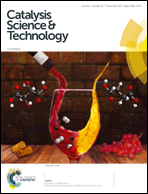Secondary diamines as a monomer from bis-hydroaminomethylation of industrial cyclic dienes†
Abstract
The bifunctional primary amine TCD-diamine (3(4),8(9)-bis(aminomethyl)-tricyclodecane) is accessible by hydroformylation and amination with ammonia of commercially available dicyclopentadiene (dcpd) and offers many applications as a monomer building block. In this work, a new simple and selective phosphorous-free and rhodium catalysed bis-hydroaminomethylation (bis-HAM) reaction of non-conjugated diolefins to secondary TCD-di(X)amine monomers for potential new adhesive or coating applications is reported. The key to a successful one phasic bis-HAM is an excess of amine and syngas pressure. For the cyclic diene dcpd, a high conversion combined with very good yields of 94% TCD-di(butyl)amine was achieved under optimised conditions. Transferability to other dienes and primary and secondary amines is effectively shown. This contribution presents for the first time the successful development of an effective application of reactive extraction as a recycling and purification method, to recycle the precious rhodium metal catalyst and separate the diamines. The ex situ reactive-extraction of the bis-HAM product is conducted using aqueous acetic acid to form a water-soluble ammonium salt. The resulting ammonium salt is mostly present in the aqueous phase while the rhodium complex is maintained in the nonpolar organic phase and is successfully reused in three recycling runs.



 Please wait while we load your content...
Please wait while we load your content...